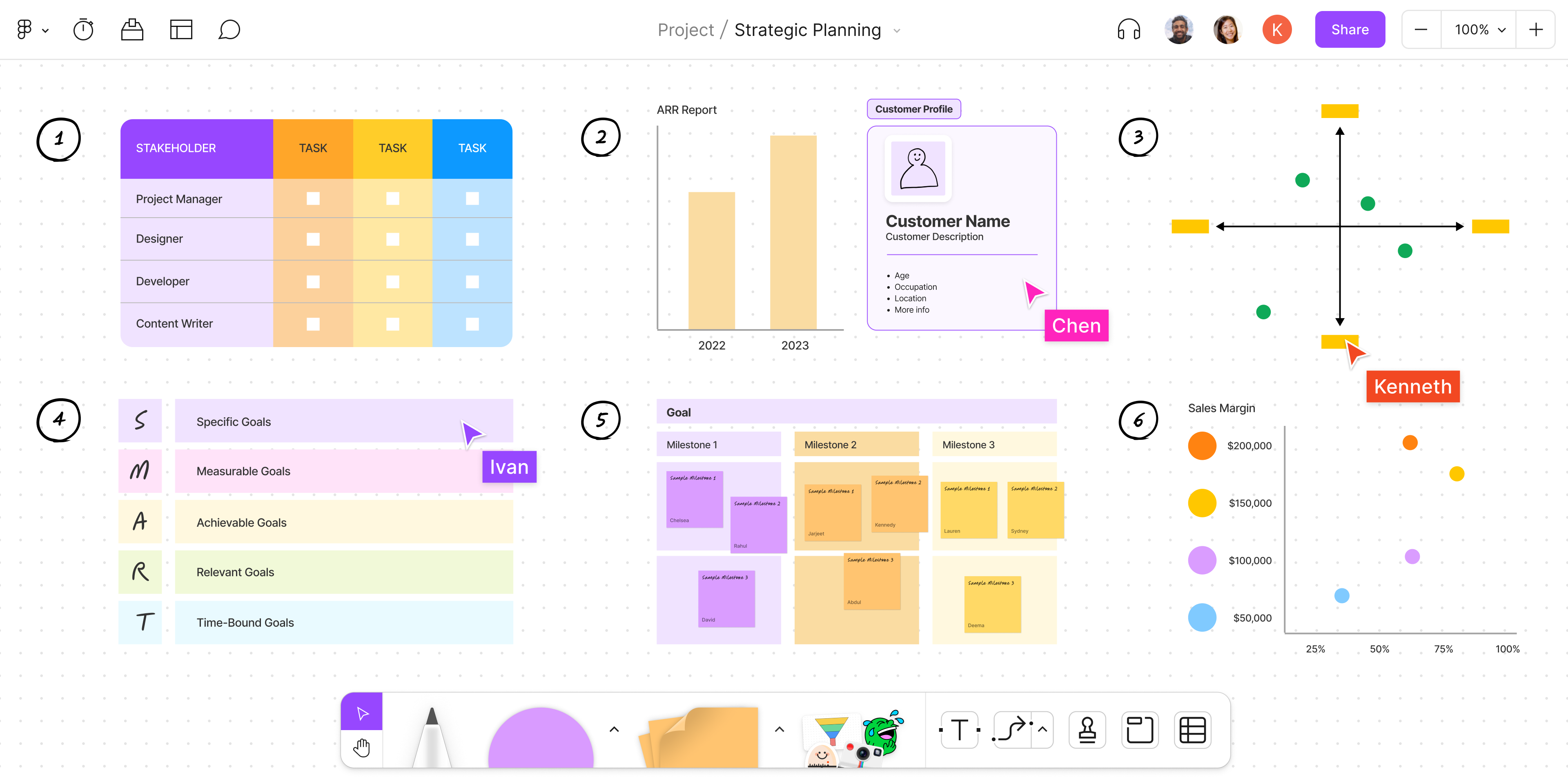Strategic Planning Process in 6 Steps

What is a strategic plan?
Whether you’re launching a new product or rebranding an established company, a strategic plan is your roadmap to success. A smart, well-researched strategic plan shows where you started, what route you're taking, and how far you've advanced toward your goal.
Strategic planning at a glance
Effective strategic plans focus attention on what matters most. To kickstart your planning process, the FigJam strategic plan template focuses on four key elements:
- Mission/vision statement. A mission statement conveys the company’s core purpose. A vision statement briefly describes the company's vision for the future, and how it's bringing that future to life.
- Key focus areas. Find places that need additional support and investment to support the vision. Look for insights using a SWOT analysis, customer research, and competitive analysis.
- Goals. According to Harvard Business School, effective strategic goals should be purpose-driven (aligned with the company’s vision and mission), long-term and forward-focused, actionable, and measurable.
- Action plan. This is where you outline your process, roles and responsibilities, and marketing plan.

Plot a map for the road ahead with FigJam
FigJam's free strategic plan template makes it easy hit the ground running. Get started today.
3 key benefits of strategic planning
- Aligns creative efforts to shared goals company-wide
- Stress-tests decision-making logic to build a more rigorous, evidence-based plan
- Tracks progress based on strategic goals
How to create a strategic plan in 6 steps
The strategic planning process can help you make any moonshot feasible, once you break it down into six steps.
Step 1: Assemble key stakeholders.
Since a strategic plan can affect the entire organization, you may have a range of stakeholders from different departments. Not sure who your key stakeholders are? Check out the FigJam stakeholder analysis template to identify valuable collaborators right from the start.
Reach out to representatives of key stakeholder groups, but don’t let the group get too big. Large groups can get bogged down in strategic planning discussions. To keep the process on track, nominate one person to manage the strategic planning process from start to finish.
Step 2: Gather relevant data.
Collect information that shows how your product, brand, or business is currently performing with customers, competitors, and the overall environment. Useful data sources may include:
- The previous strategic plan
- Reports from key executives at all-hands, shareholder meetings, and industry conferences
- Financial records
- Research on the competition
- Industry studies
- Customer data
- Sales data from earlier years
- Market analysis
Step 3: Gather insights.
When you organize your data, you'll notice patterns start to emerge. One way to capture these observations is with a SWOT chart, identifying company Strengths, Weaknesses, Opportunities, and Threats. Start yours with a simple grid, or try Figma's SWOT analysis template.
Step 4: Define strategic objectives.
Promises are nice, but not always actionable. To improve strategic plan goal tracking, Forbes recommends setting SMART goals:
- Specific. Say it straight before you say it great. Explain exactly what you want to accomplish and how you’ll do it.
- Measurable. Objectives should be objective, not opinions. A goal like “leave the competition in the dust” may be motivating, but how can you tell when it's accomplished? On the other hand, “increase market share by 15% over the next three fiscal years” can be tracked with data.
- Achievable. If a goal is set too high, no one will reach for it. A process map can help you break down a moonshot into small, achievable steps.
- Relevant. Goals should be purposeful, not arbitrary. Align objectives with your organization's mission, vision, and values.
- Time-bound. Without a clear timeframe for completion, your deadlines will get pushed. A timeline of key milestones helps ensure your timing is realistic.
Step 5: Develop your action plan.
To put your strategic plan into motion, the FigJam action plan template covers all the basics:
- Breaking down strategic objectives into achievable milestones
- Identifying essential resources, including funds, time, and supplies
- Tagging key team members to carry out the action plan
- Setting a timeline for implementation
Step 6: Implement, monitor, and update.
The best-laid plans only work when you regularly track progress, adapt, and adjust tasks when needed. To keep stakeholders informed and involved, you can share Key Performance Indicators (KPIs) using the KPI dashboard in FigJam.
3 industry best practices for strategic planning
- Keep it short. Gartner recommends a one-page strategic plan. Include a statement of strategy, a before-and-after description, and five to seven initiatives to support your goals.
- Deliver a clear, consistent message. Effective messaging generates support from leadership and drives engagement among the workforce.
- Set clear priorities. Stakeholders need to understand the new strategic priorities, and why they're changing. A 20-year study of strategic practice reveals the #1 reason for failure: “poor communication of strategy and implementation.”
5 pro tools for effective strategic planning
FigJam's free strategic planning templates enhance team communication, track progress, and facilitate reviews. Effective strategic planning starts with these five proven tools:
- Vision, Mission, Values Pyramid. Capture your organization’s purpose and vision for the future.
- RACI Matrix. Clarify everyone’s roles in bringing the vision to life.
- Gantt chart maker. Illustrate timelines and keep your projects on track.
- Quarterly Business Review. Review progress and plan goals.
- Work plan. Connect, collaborate, and create lasting success.
Turn strategic plans into reality with FigJam
An effective strategic plan isn't just another document—it's a shared vision for the future that's both inspirational and feasible. FigJam strategic plan templates give you the structure, tools, and prompts you need to put dreams into action.
Sources
[1] https://iveybusinessjournal.com/publication/strategic-planning-a-roadmap-to-success/
[2] https://blog.hubspot.com/marketing/competitive-analysis-kit
[3] https://online.hbs.edu/blog/post/why-is-strategic-planning-important
[4] https://www.amanet.org/articles/assembling-right-people-for-strategic-business-planning/
[5] https://open.lib.umn.edu/humanresourcemanagement/chapter/2-1-strategic-planning/
[6] https://www.forbes.com/advisor/business/smart-goals/
[7] https://www.gartner.com/smarterwithgartner/9-steps-successful-functional-strategic-planning
[8] https://www.bridgesconsultancy.com/research-case-study/research/
Keep reading

What is strategic planning
What is strategic planning and why is it more important?
Mehr erfahren

What is the strategic management process
Every company needs an in-depth plan to stay ahead of market shifts—and their competition.
Mehr erfahren

Agile vs. waterfall methodologies
Find out which approach is best for your next big project
Mehr erfahren




